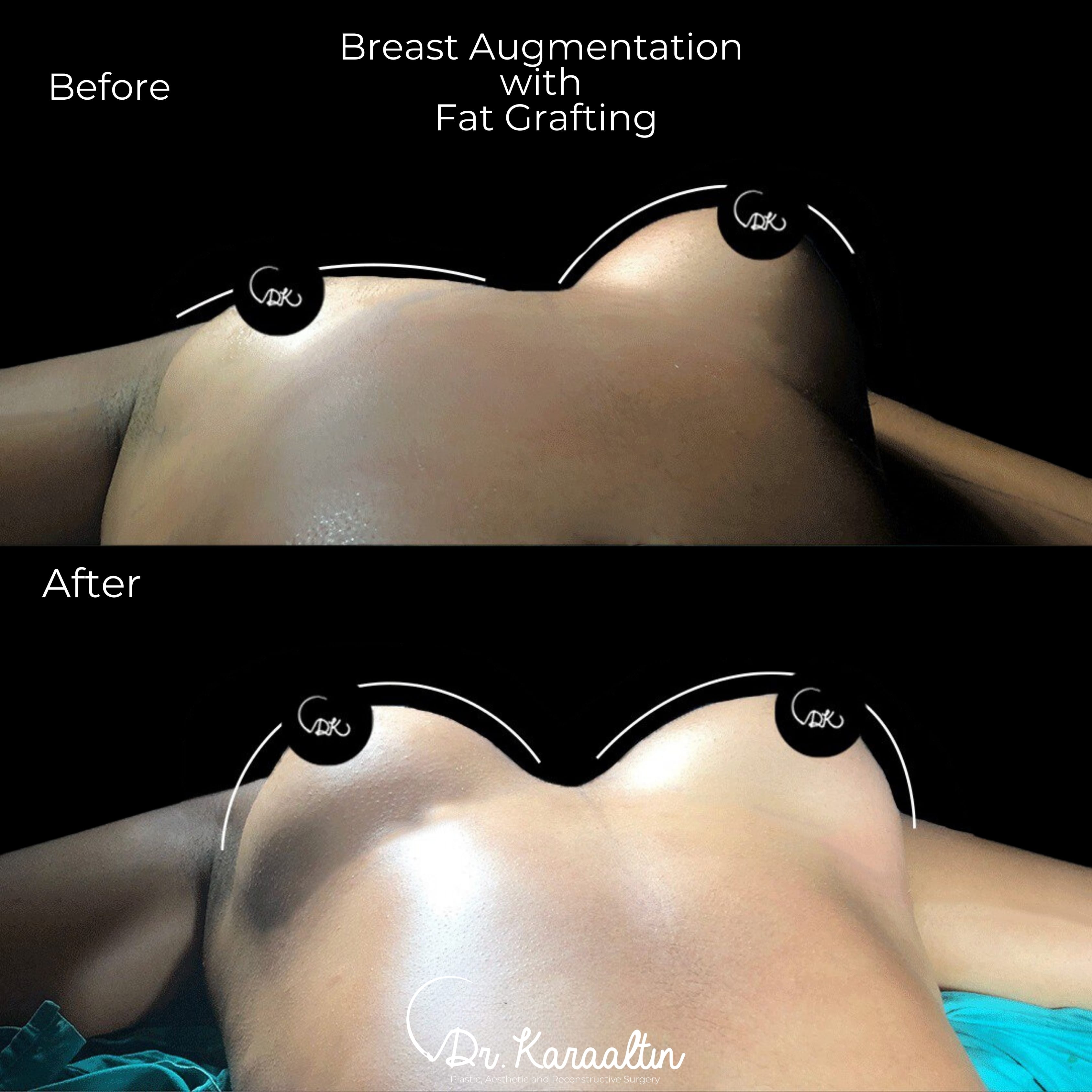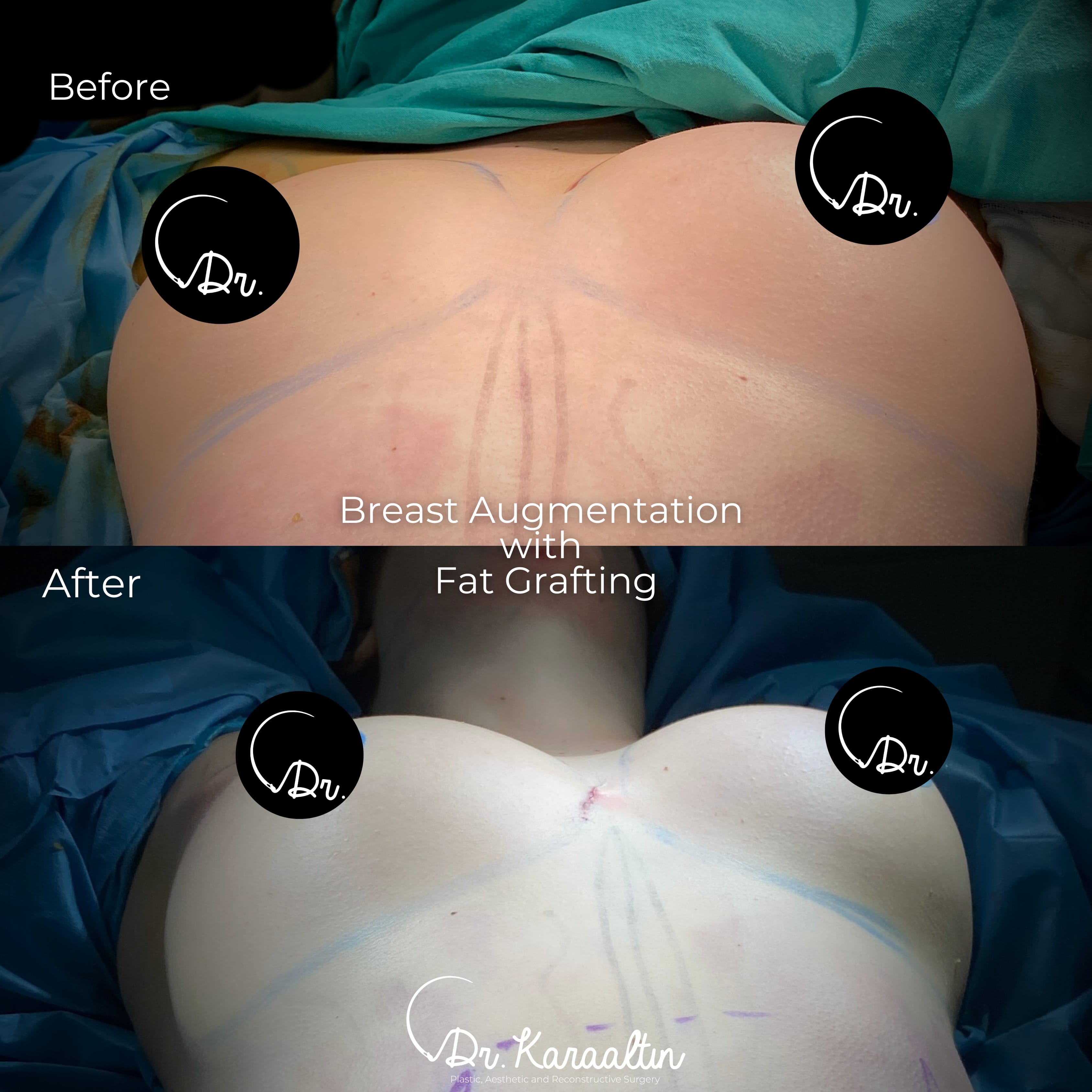

This technique uses fat from your own body to enlarge and uplift the breasts instead of silicone or saline implants. In the procedure, Dr. Karaaltın harvests fat from one or multiple areas of your body with liposuction and moves it to your breasts. Structural fat grafting can create a natural, long-lasting result with minimal incisions and limited scarring. The only drawback of the procedure is the unpredictability of the retention rate of the transferred fat. Hence, you should be aware that depending on your expectations and outcomes, a second session may be necessary to achieve the desired result.
Recent advances have eliminated any bias and misdiagnosis possibilities regarding cyst and calcification formation after breast fat grafting.
Because fat grafting uses fat from the patient’s own body for breast augmentation instead of silicone or saline implants, there’s no chance for reaction or capsular contracture. This means that the procedure is open to many candidates. It can be especially useful for people seeking body contouring or liposuction combined with their breast’s augmentation with fat.
Before starting structural fat grafting for breast augmentation, you will meet with Dr. Karaaltın to learn about the procedure. You will discuss your medical history and goals for the procedure.
Dr. Karaaltın will examine you, and a team member will photograph your body. These photos will be used to create a custom plan for your surgery.
The plan will be detailed to determine your expected cup size and the areas from which you wish to harvest the fat. The team will mark and draw the designated areas for:
The procedure starts with fat removal from your body; this can be done from a single area or multiple areas as per your request. If there is a particularly large amount of excess fat in one area, that area can be used as the sole site for fat removal. Dr. Karaaltın will consider the following body areas:
Dr. Karaaltın will use liposuction for fat removal. After the fat removal, the team will refine and concentrate the tissue by removing blood, fat, and water. Then, the refined tissue will be used to carefully shape each breast to achieve a natural appearance.
Dr. Karaaltın will place the fat in small amounts, making hundreds of passes through a small incision at the bottom or side of the breast.
The procedure takes three to five hours.
Your recovery from structural fat grafting depends mainly on how many donor sites your doctor used for harvesting the fat. You will likely experience bruising and swelling in those areas for at least four to six weeks. Your breasts may be bruised and swollen, but in most cases, you’ll experience little or no pain. Soreness can last for approximately two to three weeks after the surgery.
You may be able to return to work in about a week or ten days. Most bruising and swelling should go away within about three weeks, but minor swelling can linger for up to six months.
You should walk as much as possible beginning the day after surgery and can return to light exercise in 10 days to two weeks. You should not put pressure on the breasts. You should sleep on your back and avoid excess lifting or upper body activity.
Compressive garments will be crucial after the procedure, some of our surgeons depending on your condition, would not recommend bras or any dressing at all.
In general, each surgery can increase your breasts by one cup size (100-150 cc of volume). Any enlargement beyond that would usually require additional procedures.
Structural fat grafting can last longer than traditional implants, which may need replacement over time. While fat is an easily damaged tissue, the structural fat grafting method injects fat to give it access to a blood supply, which makes it last. Whatever tissue remains after about 48 hours after surgery will be permanent. The rest will be resorbed by time and this might continue up to four months until the final outcome is achieved.
The procedure also allows the surgeon to shape your breasts more easily than with silicone or saline implants.
Complications are rare with structural fat grafting, but those that can occur include:
Calcification, cysts and lumps can appear after fat transfer, just as with other breast procedures.
The American Society of Plastic Surgery has determined that structural fat grafting to the breast is safe and does not lead to a higher rate of breast cancer. There also is no evidence that fat grafting to the breast makes it more difficult to detect breast cancer.
What are the benefits of breast augmentation with fat grafting?
Breast augmentation can improve the size and shape of breasts and correct asymmetry.
Structural fat grafting specifically can to certain extent lift sagging breasts, improve shape, and even cover up existing implants (the hybrid implant fat grafting procedure).Other benefits of structural fat grafting for breast augmentation include:





